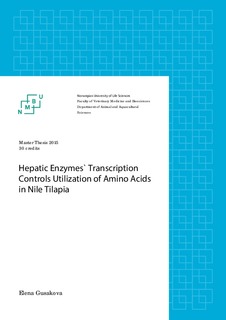| dc.description.abstract | Nile tilapia is an attractive fish species for farming, due to its resistance to diseases and poor environmental quality. Tilapia can efficiently utilize low quality feed. Fish feed occurs approximately 40% of total farming costs. Animal nutritionists try to deal with feed costs reduction by using alternative less expensive ingredients, which could compose valuable feed, well-balanced with all nutrients. One of the major nutrient is protein, which takes 30% of the feed contents. Protein utilization and nitrogen excretion are the stumblingstones in aquaculture.
In our experiment, we prepared plant ingredient based diet with 31% of crude protein, 37% of starch and 6 % of fat in the dry matter, and supplemented with crystalline amino acids. The task was to see the physiological responses of the fish during protein turnover, as well as perform transcriptome analysis, based on qRT-PCR. The hypothesis was that enzymes within the organism control amino acid utilization, and their transcription is linked to fish physiological responses.
RNA were isolated from fish liver from each of 8 tanks at 2 hours after last feeding and 10 hours after last feeding. Additionally, we defined free amino acid blood plasma at 2, 6 and 10 hours after last feeding. At 45th day of experiment, ammonia was measured in closed stagnant system.
In our experiment we performed that enzymes’ transcription controls utilization f amino acids in Nile tilapia. For the analysis of correlations between blood clearance rate of individual amino acids and gene expression levels, we divided all correlations on groups due to metabolic intermediates, which could participate in gluconeogenesis or citric acid cycle. ALAT correlates to alanine, cysteine, glycine, serine, threonine, which share pyruvate as metabolic intermediate. Asparagine and aspartate, phenylalanine, tyrosine, arginine, glutamine, histidine, proline ends up with fumarate, α-ketoglutarate, oxaloacetate. These amino acids correlates to AMPD, which is the limit enzymes in purine nucleotide cycle.
MAB has the majority correlations with clearance pattern of branch-chained amino acids (leucine, valine, isoleucine), some non-polar amino acids (methionine, leucine, valine) and aromatic amino acids (phenylalanine, tyrosine), those which have acetoacetyl-CoA intermediate (tryptophan, lysine) and pyruvate intermediate (cysteine and glycine). Frequent correlations of MAB with the majority of amino acids and especially leucine, has a direct influence in proteolysis and amino acid catabolism. This hypothesis is also proved by MAB correlations with digested protein (R2=0.792, P=0.003) and excreted nitrogen. Moreover, correlations between MAB and nitrogen excreted and correlations between digested protein and nitrogen excreted share common pattern. We suppose MAB encodes enzyme, participating directly in one of reactions in protein turnover, or serving as indicator of protein catabolic reaction. | nb_NO |

